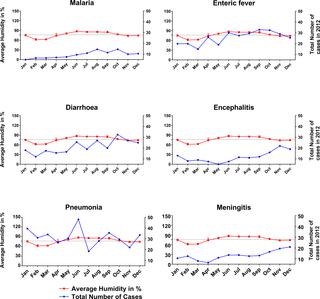Our official English website, www.x-mol.net, welcomes your feedback! (Note: you will need to create a separate account there.)
The association between temperature, rainfall and humidity with common climate-sensitive infectious diseases in Bangladesh.
PLOS ONE ( IF 3.7 ) Pub Date : 2018-06-21 , DOI: 10.1371/journal.pone.0199579 Fazle Rabbi Chowdhury 1, 2, 3, 4 , Quazi Shihab Uddin Ibrahim 5 , Md Shafiqul Bari 5 , M M Jahangir Alam 5 , Susanna J Dunachie 2, 3, 4 , Alfonso J Rodriguez-Morales 6 , Md Ismail Patwary 5
PLOS ONE ( IF 3.7 ) Pub Date : 2018-06-21 , DOI: 10.1371/journal.pone.0199579 Fazle Rabbi Chowdhury 1, 2, 3, 4 , Quazi Shihab Uddin Ibrahim 5 , Md Shafiqul Bari 5 , M M Jahangir Alam 5 , Susanna J Dunachie 2, 3, 4 , Alfonso J Rodriguez-Morales 6 , Md Ismail Patwary 5
Affiliation

|
Bangladesh is one of the world's most vulnerable countries for climate change. This observational study examined the association of temperature, humidity and rainfall with six common climate-sensitive infectious diseases in adults (malaria, diarrheal disease, enteric fever, encephalitis, pneumonia and bacterial meningitis) in northeastern Bangladesh. Subjects admitted to the adult medicine ward of a tertiary referral hospital in Sylhet, Bangladesh from 2008 to 2012 with a diagnosis of one of the six chosen climate-sensitive infectious diseases were enrolled in the study. Climate-related data were collected from the Bangladesh Meteorological Institute. Disease incidence was then analyzed against mean temperature, humidity and average rainfall for the Sylhet region. Statistical significance was determined using Mann-Whitney test, Chi-square test and ANOVA testing. 5033 patients were enrolled (58% male, 42% female, ratio 1.3:1). All six diseases showed highly significant (p = 0.01) rises in incidence between the study years 2008 (540 cases) and 2012 (1330 cases), compared with no significant rise in overall all-cause hospital admissions in the same period (p = 0.19). The highest number of malaria (135), diarrhea (266) and pneumonia (371) cases occurred during the rainy season. On the other hand, the maximum number of enteric fever (408), encephalitis (183) and meningitis (151) cases occurred during autumn, which follows the rainy season. A positive (P = 0.01) correlation was observed between increased temperature and the incidence of malaria, enteric fever and diarrhea, and a negative correlation with encephalitis, meningitis and pneumonia. Higher humidity correlated (P = 0.01) with a higher number of cases of malaria and diarrhea, but inversely correlated with meningitis and encephalitis. Higher incidences of encephalitis and meningitis occurred while there was low rainfall. Incidences of diarrhea, malaria and enteric fever, increased with rainfall, and then gradually decreased. The findings support a relationship between weather patterns and disease incidence, and provide essential baseline data for future large prospective studies.
中文翻译:

孟加拉国温度、降雨量和湿度与常见气候敏感传染病之间的关系。
孟加拉国是世界上最容易受到气候变化影响的国家之一。这项观察性研究调查了孟加拉国东北部温度、湿度和降雨量与成人六种常见气候敏感传染病(疟疾、腹泻病、肠热病、脑炎、肺炎和细菌性脑膜炎)之间的关系。2008 年至 2012 年入住孟加拉国锡尔赫特市一家三级转诊医院成人内科病房并诊断出六种选定的气候敏感传染病之一的受试者参加了这项研究。气候相关数据是从孟加拉国气象研究所收集的。然后根据锡尔赫特地区的平均温度、湿度和平均降雨量分析疾病发病率。使用曼-惠特尼检验、卡方检验和方差分析检验确定统计显着性。共有 5033 名患者入组(58% 男性,42% 女性,比例 1.3:1)。在 2008 年(540 例)和 2012 年(1330 例)研究年之间,所有六种疾病的发病率均出现显着上升(p = 0.01),而同期全因住院总人数没有显着上升(p = 0.19) )。雨季期间疟疾(135例)、腹泻(266例)和肺炎(371例)病例数最多。另一方面,肠热病(408例)、脑炎(183例)和脑膜炎(151例)的病例最多出现在雨季过后的秋季。气温升高与疟疾、肠热病、腹泻的发病率呈正相关(P=0.01),与脑炎、脑膜炎、肺炎的发病率呈负相关。较高的湿度与较高的疟疾和腹泻病例数相关(P = 0.01),但与脑膜炎和脑炎呈负相关。降雨量少时,脑炎和脑膜炎的发病率较高。腹泻、疟疾、肠热病发病率随降雨量增加而增加,后逐渐减少。这些发现支持了天气模式与疾病发病率之间的关系,并为未来的大型前瞻性研究提供了必要的基线数据。
更新日期:2018-06-22
中文翻译:

孟加拉国温度、降雨量和湿度与常见气候敏感传染病之间的关系。
孟加拉国是世界上最容易受到气候变化影响的国家之一。这项观察性研究调查了孟加拉国东北部温度、湿度和降雨量与成人六种常见气候敏感传染病(疟疾、腹泻病、肠热病、脑炎、肺炎和细菌性脑膜炎)之间的关系。2008 年至 2012 年入住孟加拉国锡尔赫特市一家三级转诊医院成人内科病房并诊断出六种选定的气候敏感传染病之一的受试者参加了这项研究。气候相关数据是从孟加拉国气象研究所收集的。然后根据锡尔赫特地区的平均温度、湿度和平均降雨量分析疾病发病率。使用曼-惠特尼检验、卡方检验和方差分析检验确定统计显着性。共有 5033 名患者入组(58% 男性,42% 女性,比例 1.3:1)。在 2008 年(540 例)和 2012 年(1330 例)研究年之间,所有六种疾病的发病率均出现显着上升(p = 0.01),而同期全因住院总人数没有显着上升(p = 0.19) )。雨季期间疟疾(135例)、腹泻(266例)和肺炎(371例)病例数最多。另一方面,肠热病(408例)、脑炎(183例)和脑膜炎(151例)的病例最多出现在雨季过后的秋季。气温升高与疟疾、肠热病、腹泻的发病率呈正相关(P=0.01),与脑炎、脑膜炎、肺炎的发病率呈负相关。较高的湿度与较高的疟疾和腹泻病例数相关(P = 0.01),但与脑膜炎和脑炎呈负相关。降雨量少时,脑炎和脑膜炎的发病率较高。腹泻、疟疾、肠热病发病率随降雨量增加而增加,后逐渐减少。这些发现支持了天气模式与疾病发病率之间的关系,并为未来的大型前瞻性研究提供了必要的基线数据。



























 京公网安备 11010802027423号
京公网安备 11010802027423号